Need a few tips and tricks to perk up the sad petunias growing in your containers or hanging baskets?
As beautiful as petunias are in the spring and early summer, by the time August rolls around, they often don’t look quite the same. Especially for those growing in hanging baskets, containers, or tight raised bed spaces.
By mid to late summer, petunias can start to look thin, tired, leggy, and downright worn out. What was once a full, bushy, blooming plant now looks a little sad – with long, empty stems, faded flowers, and sparse foliage. Unfortunately, for many gardeners, this is the point when they simply give up and toss their plants out!
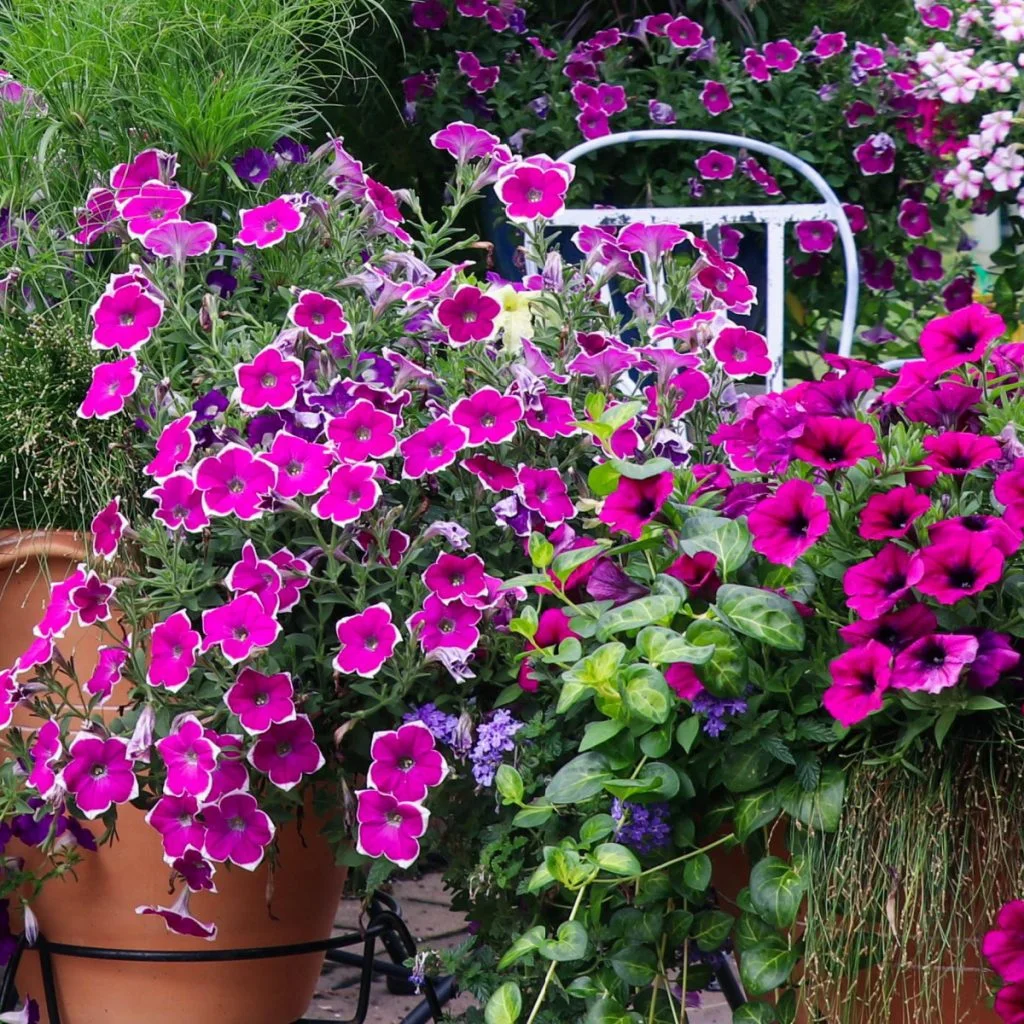
But here’s the good news – there’s no need to give up on your petunias in late summer. With just a little bit of attention and the right kind of care, your worn-out plants can bounce back quickly. In fact, they can be back to blooming big, bright, and full in just a few weeks – and even keep flowering well into fall.
The secret? It all lies in two key late summer tasks – pruning and feeding. And when done the right way, these two simple steps will completely revitalize your plants.
How To Perk Up Your Petunias In Late Summer
Why Petunias Struggle In Late Summer
There are a few common reasons why petunias begin to look bad as the summer progresses. First and foremost, they are heavy bloomers. All of that flowering early in the season takes a lot out of the plant and soil, especially when grown in a limited space like a pot or basket.
As the plant puts more and more energy into producing new blooms, it can become exhausted if that energy isn’t replenished. Another issue is watering. In the hotter months, containers and baskets dry out quickly. This puts stress on the roots and limits the plant’s ability to take in the nutrients it needs to stay strong and full.
Finally, the buildup of spent blooms and leggy stems starts to take over. And it leaves the plant looking thin and tangled instead of lush and blooming. But again, none of these issues mean your petunias are beyond saving.
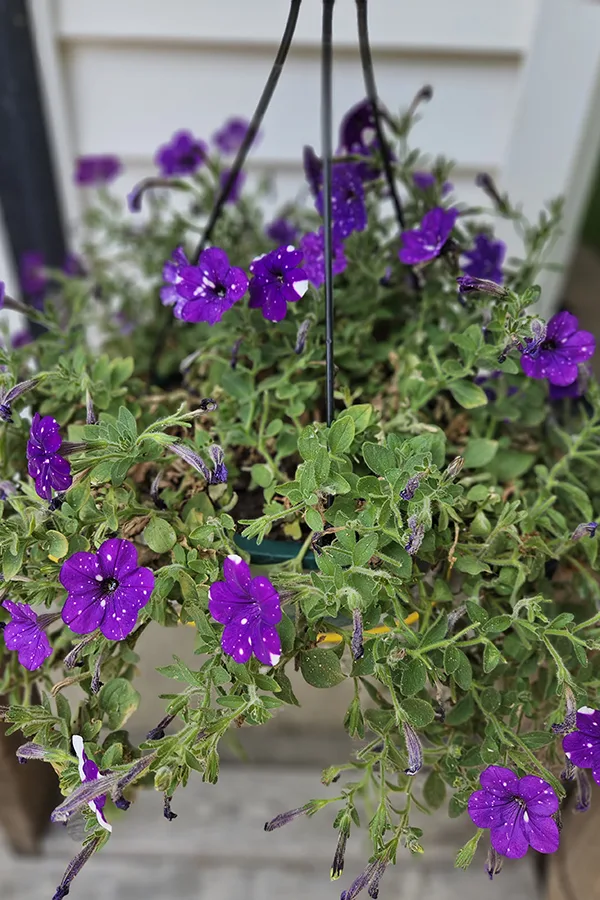
Cutting Back Petunias
The first and most important step in reviving petunias is cutting them back. This may seem extreme – especially if your plants still have a few blooms here and there. But cutting back is what triggers the plant to begin growing again. It’s a way of hitting the reset button. And it works wonders!
Petunias tend to grow long, leggy stems as they age. These stems get farther and farther away from the base of the plant and produce fewer leaves and blooms.
By the time late summer hits, much of the plant’s foliage and flowers are all concentrated at the very tips of these long stems, giving the entire plant a spindly appearance. When you cut those long stems back, you encourage the plant to branch out.
Instead of focusing all of its energy on trying to push a few more flowers out at the end of a tired stem, the plant sends out new growth from lower down. This growth will be denser, more compact, and much more productive in terms of foliage and bloom production. And will it ever help to perk up your petunias!
How To Cut Back Petunias
To cut your petunias back, take a pair of clean garden scissors or snips and trim each stem back by about half to two-thirds of its current length. Be sure to cut just above a set of leaves. This is where new growth will emerge.
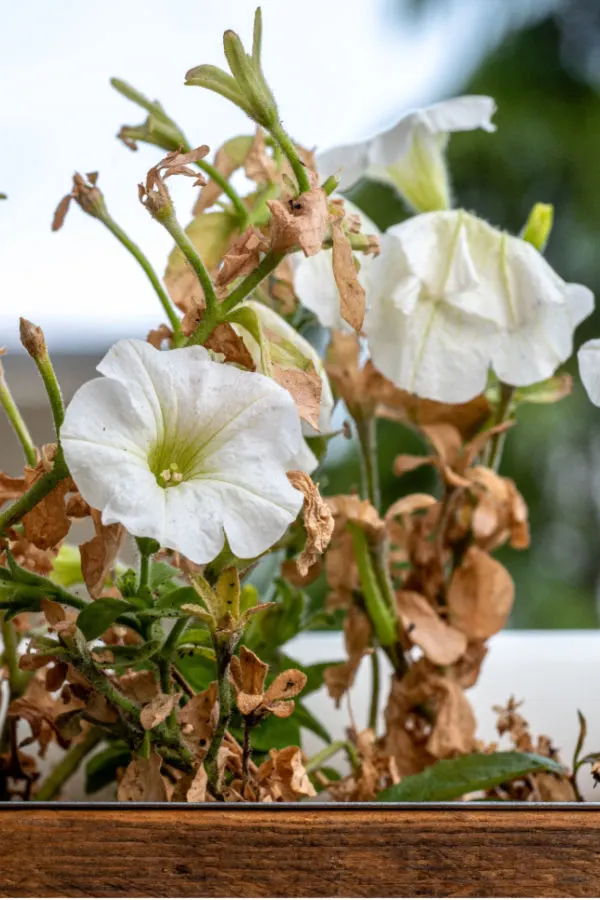
If your petunias are extremely leggy, you can even cut them back by as much as three-fourths. It may seem drastic, but the results are definitely worth it.
After pruning, you may be left with a plant that looks pretty bare. That’s perfectly normal. Within a week or two, you’ll see new shoots forming, and soon the plant will begin to fill out again. Within three weeks, your petunias will be back to looking lush and colorful – as long as you feed them too!
How To Perk Up Petunias With Fertilizer
Once you’ve trimmed your petunias back, the next step is giving them the fuel they need to grow again. Petunias need energy to push out all of that new growth. And for plants in containers, that energy has to come from an outside source. And that is exactly where liquid fertilizing comes in.
Feeding petunias with a well-balanced liquid fertilizer is one of the fastest ways to bring them back to life. But not just any fertilizer will do. Petunias respond best to fertilizers that are specifically formulated for them. Especially ones that have higher levels of nitrogen and potassium, and lower levels of phosphorous.
Look for a liquid fertilizer with a nutrient ratio near 20-6-20. These numbers represent the percentage of nitrogen (N), phosphorous (P), and potassium (K) in the mix. The higher nitrogen content will help the plant rebuild its foliage quickly. Nitrogen is what gives leaves their deep green color and encourages strong stem and leaf growth.
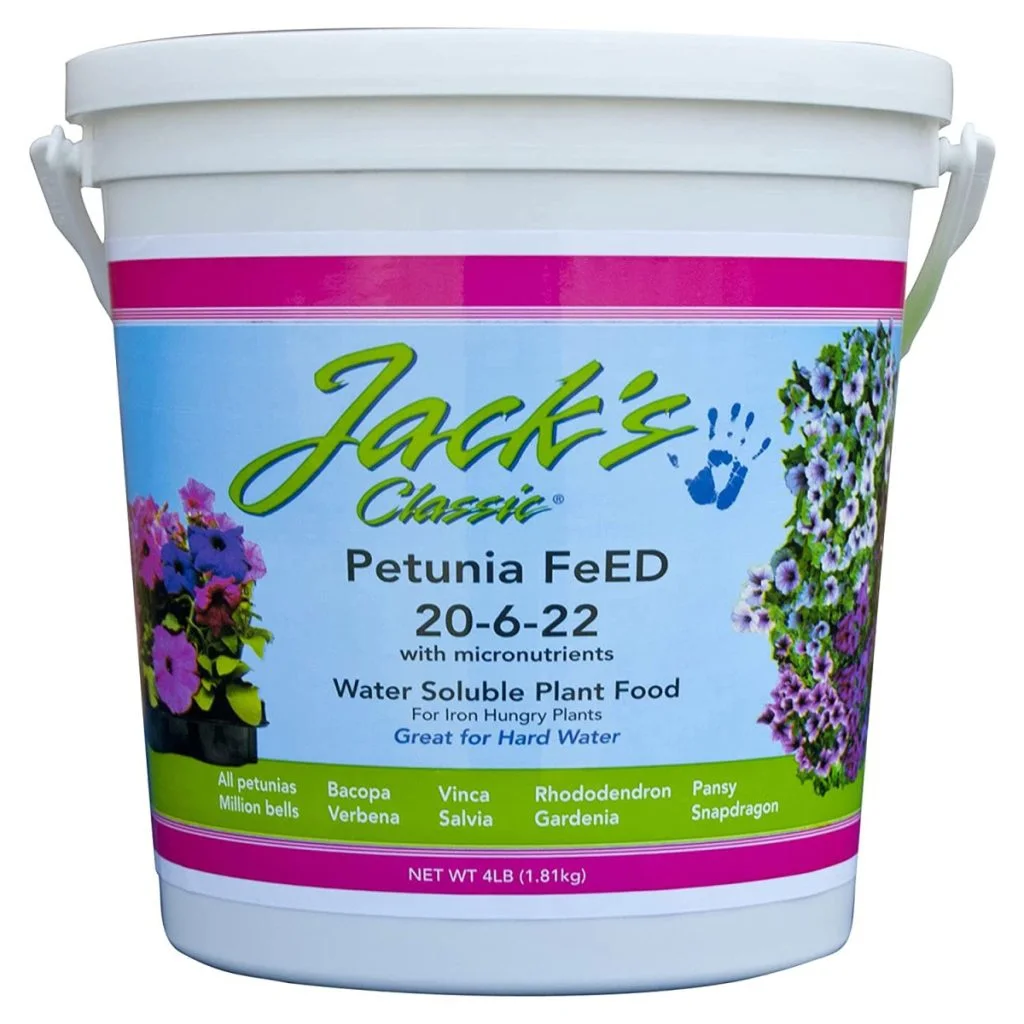
Meanwhile, the potassium helps the plant build energy and power up its flower production. Potassium is essential for creating bigger, more vibrant blooms that last longer and appear more often.
The lower amount of phosphorous is important too. Many bloom booster fertilizers are high in phosphorous, but for petunias, too much can actually reduce flowering over time. It can lead to an overload of nutrients that interfere with the plant’s ability to uptake other key minerals.
That’s why the 20-6-22 mix above works especially well for petunias. It has the right balance to encourage blooms without causing other problems! Affiliate Link: Jacks Classic No.1.5 20-6-22 Petunia Feed
How To Feed Petunias To Perk Them Up
Apply the liquid fertilizer at half of the recommended strength every 5 to 7 days. This lower strength helps prevent over-fertilizing while still supplying a steady stream of nutrients.
Be sure to apply the solution directly to the soil and not on the leaves or flowers, as it can sometimes burn the foliage in hot sunlight. Water your petunias first, then apply the fertilizer. This helps prevent root shock and allows the plant to absorb the nutrients more effectively.

Watering After Pruning
After trimming and fertilizing, it’s also important to pay close attention to watering. In late summer, heat and sun can dry out pots and hanging baskets in just a few hours. At the same time, overwatering can create soggy soil and lead to root rot. That’s why consistent, deep watering is key.
Check the moisture level of your containers every day by sticking your finger about an inch into the soil. If it feels dry, it’s time to water. When you do water, soak the entire pot until you see water running out of the drainage holes. This deep soak encourages the roots to grow downward and keeps the plant hydrated longer.
Avoid watering just a little bit at a time, as this only wets the top layer of soil and does nothing to help deep roots. Also, try to water in the morning rather than the heat of the day. When it comes right down to trying to perk up your petunias – watering really is just as vital as fertilizing!
Deadheading As New Blooms Appear
Once your petunias start bouncing back and blooming again, be sure to keep deadheading them regularly. Deadheading is the process of removing spent blooms before they go to seed.
This not only keeps your plants looking neat, but also encourages them to continue producing more flowers. See our article: Deadheading Petunias – The Secret To Keep Your Petunias Flowering Big!
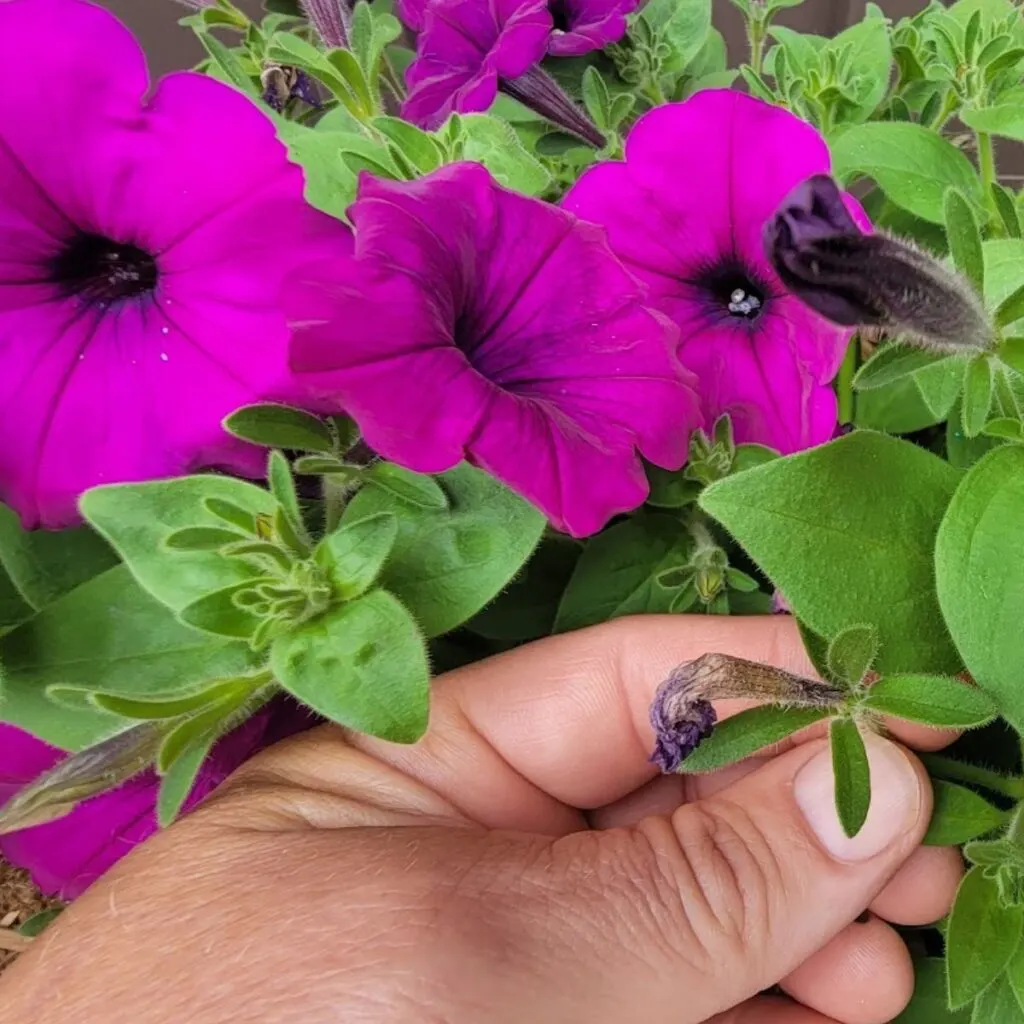
When a petunia bloom starts to fade and die off, pinch it off right at the base where the flower meets the stem. This tells the plant to stop putting energy into the old bloom and redirect it into new flower production instead.
If left in place, dying blooms will eventually begin forming seeds. When that happens, the plant thinks its job is done and will stop flowering. Make deadheading a part of your regular routine. Especially in late summer when you’re trying to get as many blooms as possible out of the plant.
Here is to taking a few simple steps to perk up your petunias in late summer. And even better, getting to enjoy them blooming big all the way into late fall!
This Is My Garden
Follow Our Facebook Page For Great Gardening Tips And Advice! This Is My Garden Facebook Page
This Is My Garden is a garden website created by gardeners, for gardeners. Jim and Mary Competti have been writing gardening, DIY and recipe articles and books and speaking for over 15 years from their 46 acre Ohio farm. They publish three articles every week, 52 weeks a year. Sign up today to follow via email, or follow along!
